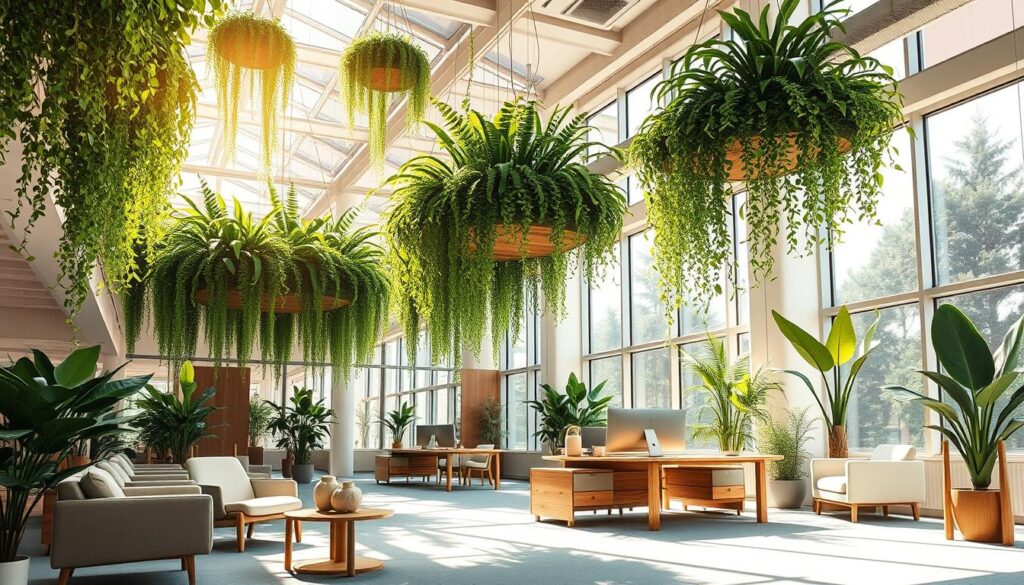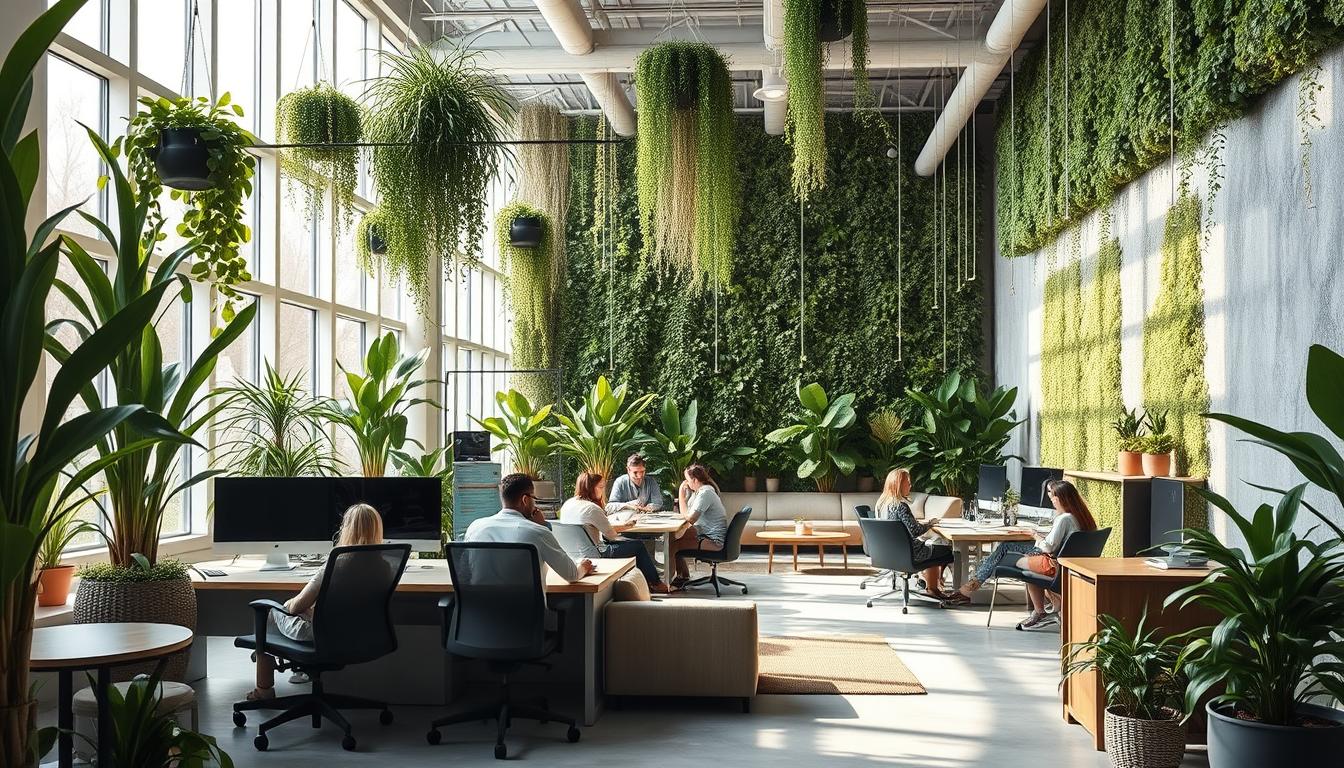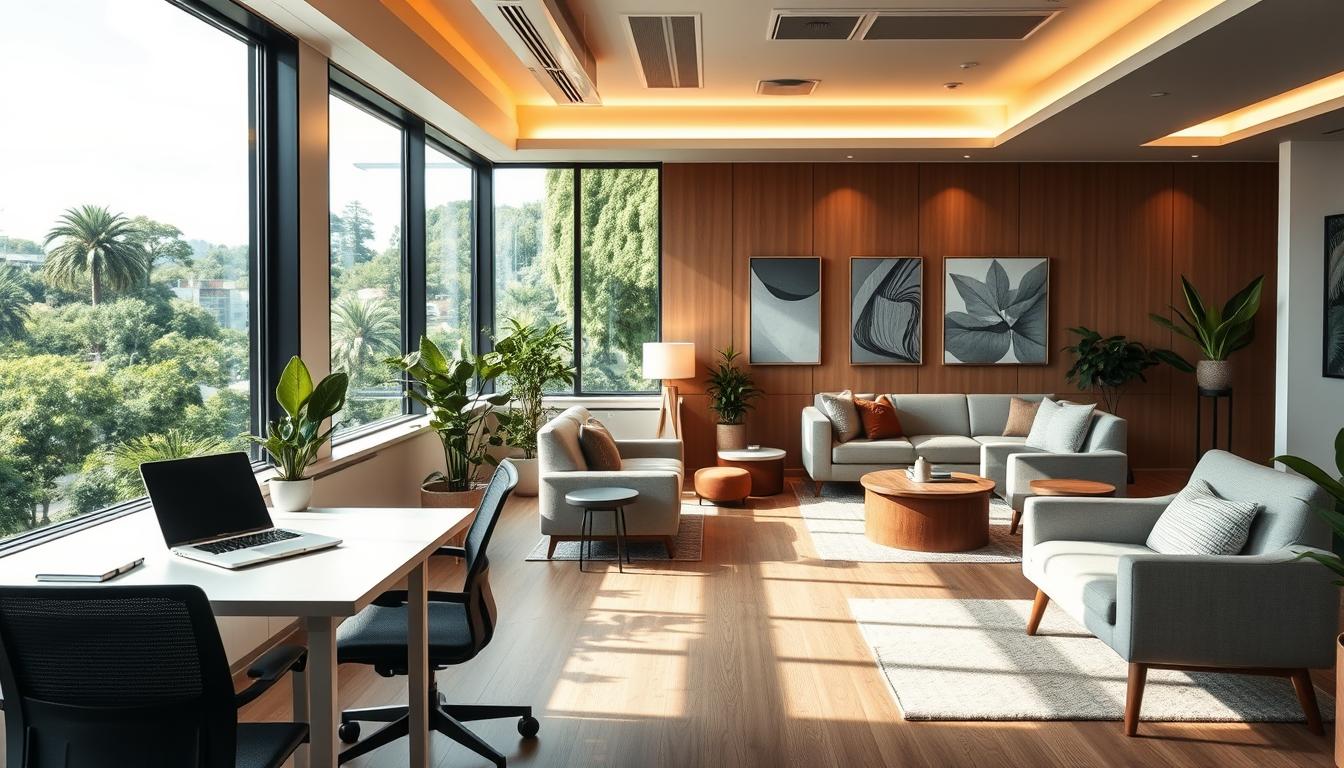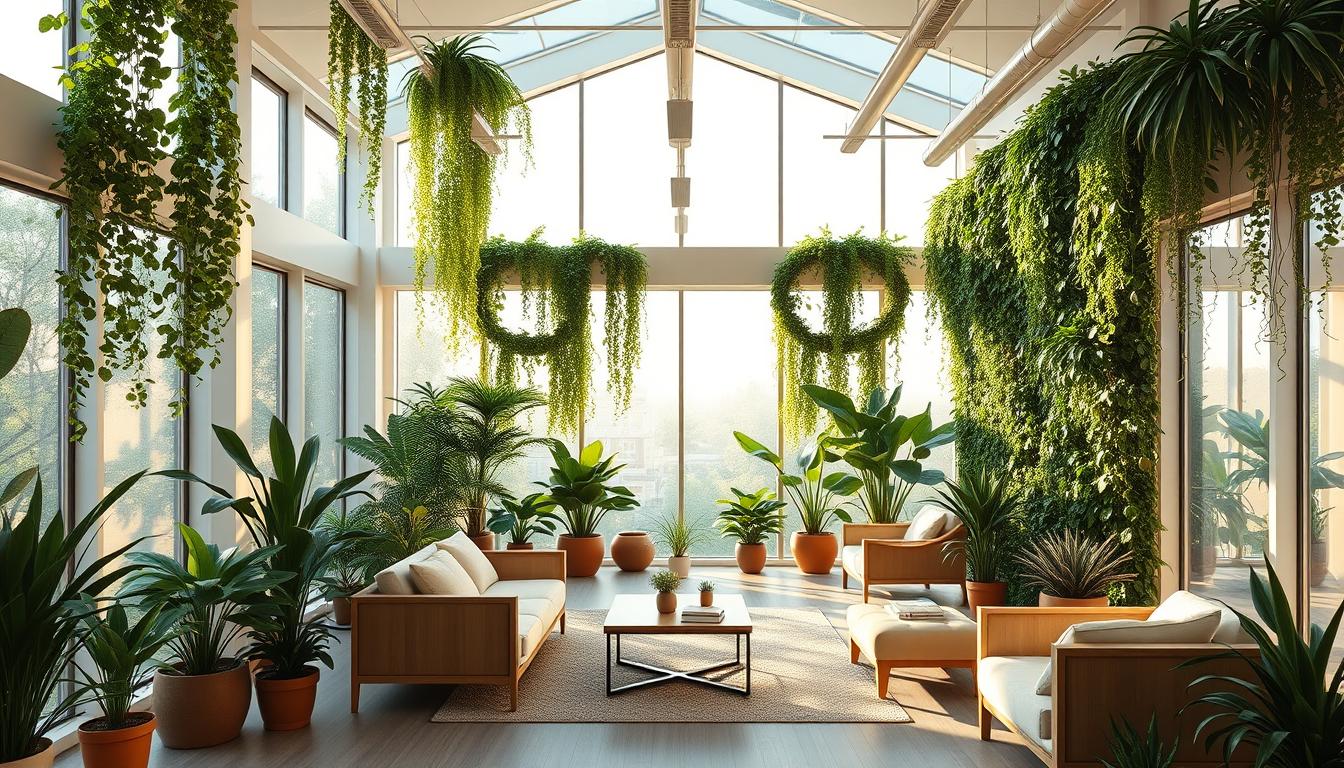The way we design office spaces today greatly affects how well employees work and feel. We’re looking at how environmental ergonomics in offices that love nature helps people. By adding natural elements to where we work, we make places where employees are healthier and work better.
Businesses that focus on their employees’ well-being create better environments. These places not only boost performance but also feel more welcoming. Let’s dive into tips for making workspaces that are good for everyone.
Understanding Biophilic Design in Modern Workspaces
“Biophilia” means “love of life” in Greek. It shows our tight link with the natural world. In today’s offices, biophilic design means bringing nature inside to help support everyone. It uses things like plants, sunlight, and natural stuff to make workspaces look great. This makes people feel better. It helps them do better at work because they feel closer to nature.
The Meaning of Biophilia
Biophilic design knows we’re all drawn to nature. It brings the outdoors inside our work areas. This way, we work in harmony with nature. It lets us feel nature’s good effects even when we’re inside. This idea goes beyond just making places look nice. It’s about better health for our bodies and minds.
Benefits of Biophilic Office Design
Using biophilic design has many good points:
- It makes mood better and cuts down stress, making work more enjoyable.
- It keeps employees happier, so they’re more likely to stay.
- People work better because they feel more awake and sharp.
- It sparks more creativity by drawing from the natural world.
These benefits make a workspace that does well. They show why it’s key to have nature in office design. This approach puts employee wellness first.

The Importance of Environmental Ergonomics in Biophilic Offices
Environmental ergonomics boosts employee health in biophilic offices—where design meets nature. It’s all about making workspaces that feel good and are good for you. People work better when their environment meets their needs, feeling happier and more productive.
Enhancing Employee Well-Being
Adding environmental ergonomics to office design makes everyone healthier. Workspaces become comfy and nice to look at, making people happier with their jobs. With plants around and good air flow, the vibe is positive. This keeps employees feeling lively, less stressed, and less tired.
Boosting Productivity and Reducing Absenteeism
Environmental ergonomics is key to doing more and staying healthy. Workstations that fit right mean less body pain and more time at work. Healthy people don’t miss work much. Well-thought-out offices lead to doing more and feeling engaged. This creates a workplace where everyone aims to do their best.
Integrating Natural Elements into Workspace Design
Adding natural elements into workspace design makes the whole area better and boosts how happy and productive employees feel. Using indoor plants and natural materials not only makes the space look good but also helps everyone feel good. This approach builds a connection with nature, creating a welcoming space for working together and being creative.
Incorporating Indoor Plants
Indoor plants are key in making workspaces vibrant and full of life. They do more than just look nice; they clean the air, lower stress, and make people happier. Easy-to-care-for plants like pothos, peace lilies, and snake plants are perfect for the office. Putting plants in different parts of the office turns it into a refreshing retreat.
Using Natural Materials and Textures
Using items made of wood, stone, and plants brings a calming, natural vibe. Adding these materials into furniture and decor makes the office cozy and unique. Interacting with natural elements can make stress go away and make people happier with their workspace. A well-thought-out design using these elements can change the workplace for the better.
Maximizing Natural Light in Biophilic Offices
Natural light is key in biophilic office design. It enhances employees’ well-being. Exposure to daylight boosts mood and energy, leading to better productivity and focus.
Maximizing natural light makes an office welcoming and encourages creativity. Effective daylight strategies improve the workspace and promote a healthier, engaging environment.
Benefits of Natural Light Exposure
Natural light in offices has many benefits:
- It improves mood and emotional stability.
- It increases energy levels, which boosts productivity.
- It enhances cognitive function and alertness, improving performance.
Strategies for Increasing Daylight in the Workspace
Here are some ways to bring more natural light into your office:
- Install large windows to let in lots of sunlight.
- Use skylights to add overhead light and create an open feel.
- Place mirrors to spread natural light throughout the office.
- Add glass partitions to keep things bright without losing privacy.
Choosing Ergonomic Furniture for Optimal Comfort
Selecting ergonomic furniture is key to better workplace comfort and health. A well-designed workplace lessens discomfort and lowers the chance of musculoskeletal issues. Knowing what makes furniture ergonomic ensures employees do their tasks well and comfortably.
Components of Ergonomic Furniture
Several key features make furniture ergonomic. Keep these in mind:
- Chairs that offer good lumbar support to keep the spine healthy.
- Desks you can adjust in height to fit everyone’s needs.
- Tools designed to reduce body strain when used.
- Footrests that help better posture and blood flow.
Importance of Adjustable Workstations
Adjustable workstations significantly improve comfort at work. They let employees change from sitting to standing, fighting the downsides of sitting too long. This change promotes more movement and less stress physically. It makes employees happier and more productive at work. Having adjustable workstations shows an employer’s dedication to their team’s health and effectiveness.
Creating Relaxation and Social Interaction Areas
It’s vital to have special areas for rest and chatting with others to increase work output. Break spaces let people take a break from normal work life and enjoy informal get-togethers. They also provide lounges and quiet spots for workers to relax and find peace during their busy day.
The Role of Break Spaces in Employee Productivity
Break spaces are key to a good work environment. They allow workers to connect, sharing interests or simple talks. These moments help by:
- Lowering stress
- Boosting creativity with relaxed talks
- Building stronger team bonds
These spaces show a company cares about mental health. This leads to more productive employees.
Designing Inviting Lounges and Quiet Zones
Lounges and quiet zones are crucial safe spots at work. They should feel cozy and look nice, with features that help people wind down. Common features are:
- Comfy places to sit
- Gentle lights and sounds
- Peaceful colors and nature themes
A well-planned relaxation area can boost team work and happiness at work besides serving as a calming retreat.
Managing Acoustics for a Healthy Work Environment
Noise in the workplace can really affect productivity and how happy employees are. It’s very important to manage noise well to make a good working environment. When you handle noise well, you can lower distractions and help everyone work better.
Noisy Workspaces: A Productivity Killer
Loud noise around can make employees upset and lose focus. Studies have found that too much noise makes people more stressed and hurts the quality of their work. It’s hard for employees to talk and concentrate with too much noise around. Noticing this problem is step one to making a workspace where people can do their best.
Implementing Acoustic Solutions
To deal with noise, companies should put money into different things that can help. These include:
- Materials that soak up sound, like carpets and curtains, which reduce noise.
- Acoustic panels that are used in the office to block and soak up sound.
- Special quiet areas, where employees can go to work without being disturbed.
When companies pay attention to noise in their workspace, they make a better place for their employees. This leads to more work done and happier employees. Putting in good noise control is a big step towards a work environment that’s healthier and more positive.
Temperature Control and Indoor Air Quality
Creating a great workspace means paying attention to temperature and air quality. This focus improves comfort for everyone working there. If it’s too hot or too cold, it’s hard for people to stay focused on their jobs. Fixing these problems makes for a much nicer place to work, helping everyone do their best.
Impact of Temperature on Employee Comfort
The link between temperature and how comfortable employees feel is key. While people have different ideas of what’s comfortable, most agree that between 68°F to 72°F is good. If it’s too hot or cold, people can get distracted, making it tough to work. Keeping the temperature just right helps everyone stay comfortable and productive.
Strategies for Improving Air Quality
Good air quality is crucial for health and happiness at work. To make the air better, you can:
- Put in efficient ventilation to keep fresh air coming in.
- Add air purifiers to get rid of harmful stuff in the air.
- Bring in plants to help clean the air naturally, making for a nicer office.
- Keep HVAC systems working well through regular checks.
Environmental Ergonomics in Biophilic Offices
Environmental ergonomics is key in making better workplace designs. It focuses on the well-being of employees. Making office spaces that improve well-being changes the workplace. It makes it cozy, relaxing, and good for getting things done. When bosses plan office layouts with care, they make a place that not only draws in great workers but keeps them happy.
Integrating Well-Being into Office Design
For employee well-being to blend well with office design, businesses need to think about:
- Choosing furniture wisely to support ergonomic principles.
- Bringing in natural light and plants for a calming atmosphere.
- Having open spaces for teamwork and quiet spots for thinking alone.
By paying attention to these aspects, firms push forward the idea of environmental ergonomics. This leads to employees who are happier and healthier.
Creating Flexible and Adaptable Workspaces
Offering flexible workspaces is crucial in today’s office design. Workers have different needs that may change. A flexible workspace offers:
- Adjustable furniture setups to meet team needs.
- Changeable workstations for different activities during the day.
- Areas that can change for meetings, chatting, or solo work.
Organizations that use these ideas not only boost employee well-being but also improve work output. Using environmental ergonomics creates a place where people can excel at their jobs. This leads to better performance and happier employees.
The Psychological Effects of Office Space Design
Office space design is key in shaping how employees feel and act at work. It shows how office layouts impact workers’ feelings and productivity. Open areas boost teamwork but can cause distractions. Closed areas might feel too tight but help people focus. Finding the right mix is crucial for making a good work environment.
Impact of Open vs. Closed Spaces
Open spaces encourage new ideas and working together. They make it easy for teams to talk and break down walls. Yet, they can be noisy and offer little privacy, which isn’t great for everyone. On the other side, closed spaces make people feel safe and help them concentrate. But, they can also make employees feel left out. A good workplace combines both for happier and more efficient teams.
Utilizing Colors and Artwork to Enhance Mood
Colors play a big role in how we feel at work. Certain colors, like blue, make us feel calm, and yellow can make us more creative. Adding art that shows what the company cares about makes employees feel more connected. Choosing the right colors and art can showcase the company’s personality. It also helps boost workers’ happiness and work performance.
Sustainability and Responsibility in Office Design
Sustainable office design combines function with care for the environment. By using eco-friendly materials, it creates a healthier workplace. This approach boosts worker productivity by making the space welcoming. Making responsible design choices can also improve profits.
Eco-Friendly Furniture and Materials
Using green materials and furniture brings many benefits. These include reclaimed wood and recycled metals, which lower harmful emissions and waste. Companies like Steelcase and Herman Miller focus on sustainability. They offer products made from materials that are good for the planet. This makes the office look better and supports green design values.
Reducing Environmental Impact in Workspaces
Lessening the environmental effect of offices needs careful planning. Some strategies are:
- Choosing modular furniture that adapts to changing needs.
- Using energy-efficient lights to save electricity.
- Adding green roofs and plant walls for better insulation and air.
These steps help create an office design that is good for both the planet and people.
Conclusion
Improving office spaces with biophilic design makes for a healthier, more productive team. Adding nature, comfy furniture, and green practices helps focus on employee health. This boosts comfort and satisfaction at work.
Biophilic design does more than look good; it builds a better company culture. Workers feel closer to their workspace, getting more motivated and productive. By adopting this approach, companies see better performance and a deepened commitment to health.
The push to refine office spaces really shows how design affects people. When businesses invest in good ergonomics and nature, they not only build healthier offices but also set the stage for future success in a changing world.



